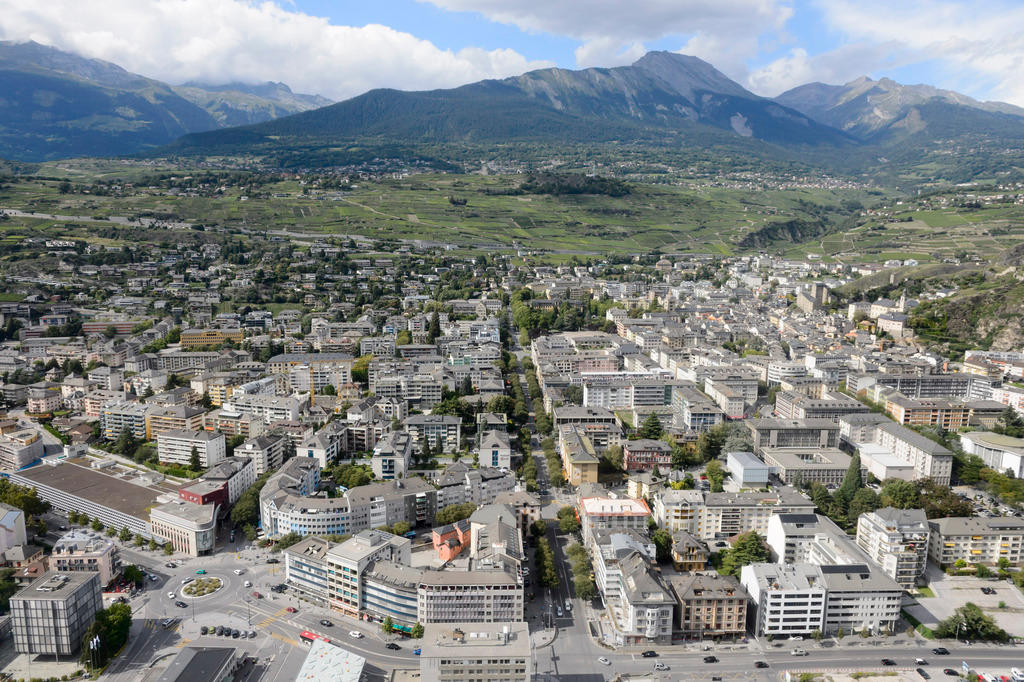When a tree is worth more than air conditioning

Rising temperatures in summer affect daily life and the health of people who live in cities. So what can be done? swissinfo.ch heads to Sion, the Swiss city that has heated up the most, to see what a difference its anti-heat plan has made.
The barbecue grills are still spotless and shiny. Five cement barbecues are waiting to be sparked up in the shade cast by freshly-planted young trees. There aren’t any tables, but apart from that, the area is ready to welcome the inhabitants of Sion, the capital of canton Valais.
We’re on Roger Bonvin Way, a pedestrian street in the eastern part of the city at the intersection of two booming quarters. What until a few months ago was a never-ending strip of cement and asphalt without a single tree or bench, is today one of the symbols of the city’s transformation.
“Previously people just walked through here. Now they stop,” says landscape architect Laurent Essig, responsible for the project to renovate Roger Bonvin Way. Here is a map of it:
The aim of the project, however, goes beyond creating a nice place to socialise. The initiative is part of a government pilot projectExternal link for adapting to climate change. Sion’s project, running between 2014 and 2016, is called AcclimataSionExternal link.
The objective is to show how spatial planning can help cities adapt to an increasingly hot and dry climate.
Sion is a special case. “It’s the Swiss city that has heated up the most,” says Lionel Tudisco from the local service for urban planning. In the past 20 years, the average temperature in Sion has gone up by one degree Celsius. Between 1960 and 1980 there were 56 days a year over 25 degrees; nowadays it is 76.
“We have the same amount of rain as Morocco,” he says.
Urban heat islands
City residents – that is, half the world’s population – know the feeling well: in summer, city centres turn into ovens. These are so-called urban heat islandsExternal link, a phenomenon linked to the density of asphalt surfaces and buildings and to the heat generated by vehicles, industry and heating systems or air conditioning.
In cities, the temperature can be four to five degrees higher than in the countryside.
Inhabitants, particularly older ones, end up suffering. But so can biodiversity and the soil, which can dry out when rainwater can no longer soak in.
“So you need to increase plant cover and modify the ground coverings,” Tudisco says, explaining that one tree provides the same coolness as five air conditioners.
The creation of green spaces has a tangible impact, adds Martine Rebetez,External link a climatologist at the University of Neuchâtel and the Swiss Federal Institute for Forest, Snow and Landscape Research.
“Putting vegetation on a paved surface can reduce the air temperature by five degrees Celsius,” she told Le Matin Dimanche newspaper.
Oasis of freshness
Along Roger Bonvin Way the authorities have planted some 700 maple trees and created 5,000 square metres of green area. The soil has become permeable and not far from the barbecues is a children’s swimming pool, which helps humidify the air and create a pleasant microclimate.
At the moment, the zone seems a bit bare, to be honest, but the promotors of the project are confident that when the trees have grown, it will become an oasis of freshness in the middle of the city.
Other projects have been realised in the commercial district. On the Espace des Remparts, near the historic old town, the uncovered car park has been transformed into an “urban drawing room”, to quote Lionel Tudisco.
“Where there were once cars, now there are trees and a pergola. The material used for the paving is lighter in colour to reflect the sun’s rays better, and it’s permeable. We’re not only reducing the heat, but we’re restoring a natural water cycle. The risk of flooding is reduced,” he said.
There are many solutions to preventing urban heat islands, as emerged during a recent international conference in Bern.External link These include promoting “corridors” that carry fresh air from surrounding forests and countryside into the city, creating green surfaces on buildings or even changing the colour of roofs.
“The temperature of cities could be easily reduced by several degrees simply by changing the colour and thermophysical properties of buildings,” says Alain Clappier, professor of climatology at the University of Strasbourg and the Swiss Federal Institute of Technology Lausanne (EPFL). On a sunny day, a roof covered in vegetation will stay at 30 degrees Celsius, compared with almost 80 degrees for a dark-coloured roof.
Awareness
So in anticipation of an increase in temperature – which in Switzerland could be on average three or four degrees by the end of the century – is it enough to plant some trees to make cities nicer to live in? Not exactly, according to the experts.
When trees are planted, it must be done correctly, Ingrid Coninx from the University of Wageningen in the Netherlands told the news agency AFPExternal link. “If the breeze is prevented from reaching the soil, there’s a risk of increasing the temperature and trapping the pollution,” she said.
But for a city wanting to adapt to global warming, the main challenge lies elsewhere, says Roland Hohmann from the Federal Office for the Environment.External link
“It’s all about managing to balance the need for densification dictated by spatial planning with the opposite requirement: the need to preserve and create non-built up zones and green spaces that make our cities’ climate pleasant,” he said.
Raising awareness among the population – and especially real estate owners – is thus crucial, adds Tudisco, especially as many buildings are still in private hands.
“This should become the rule, but it only comes from informing people about it.”
What are other Swiss cities doing?
A number of cities have begun focusing on seemingly small climate-related measures, like paying closer attention to the direction, the surface and the height of its buildings; or building car parks that use sustainable materials and techniques for permeable pavements that allow storm-water to move through the surface.
All of these can have an effect on how heat is felt, according to Melanie Butterling of the Federal Office for Spatial Development.
“Cities are conscious of the problem of heat islands and of the challenges,” she told swissinfo.ch.
Zurich, the largest Swiss city, studied what influences urban climate and started to consider how to respond. Its authorities now recommend, for example, limiting the height and density of buildings to allow more air to freely circulate.
In the Swiss capital Bern, city officials launched a pilot project to study what role trees play in urban environments challenged by rising temperatures, and how they can be better managed. Elsewhere, Lausanne is increasing the use of vegetation on roofs.
What is your city like in summer time? Which anti-heat measures are the best? Tell us in the comments section below.
Translated from Italian by Thomas Stephens

In compliance with the JTI standards
More: SWI swissinfo.ch certified by the Journalism Trust Initiative














You can find an overview of ongoing debates with our journalists here . Please join us!
If you want to start a conversation about a topic raised in this article or want to report factual errors, email us at english@swissinfo.ch.